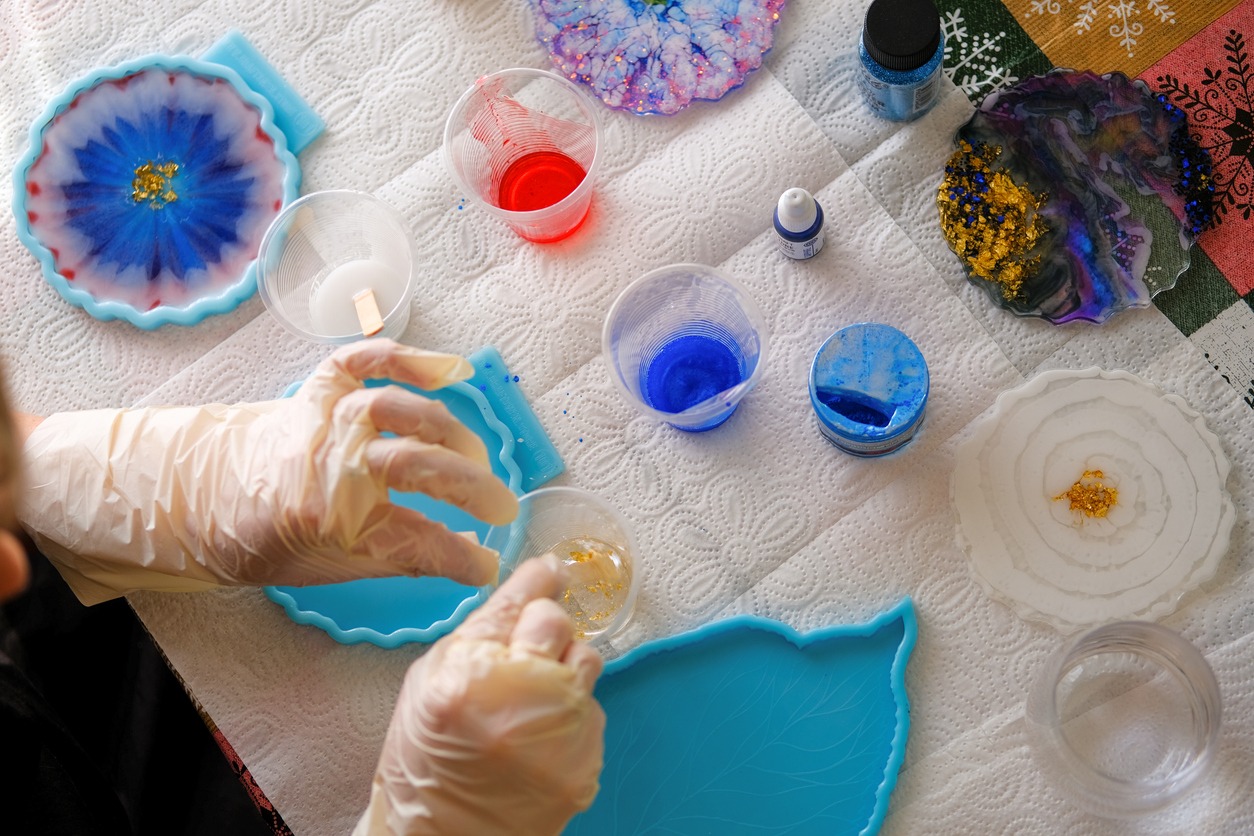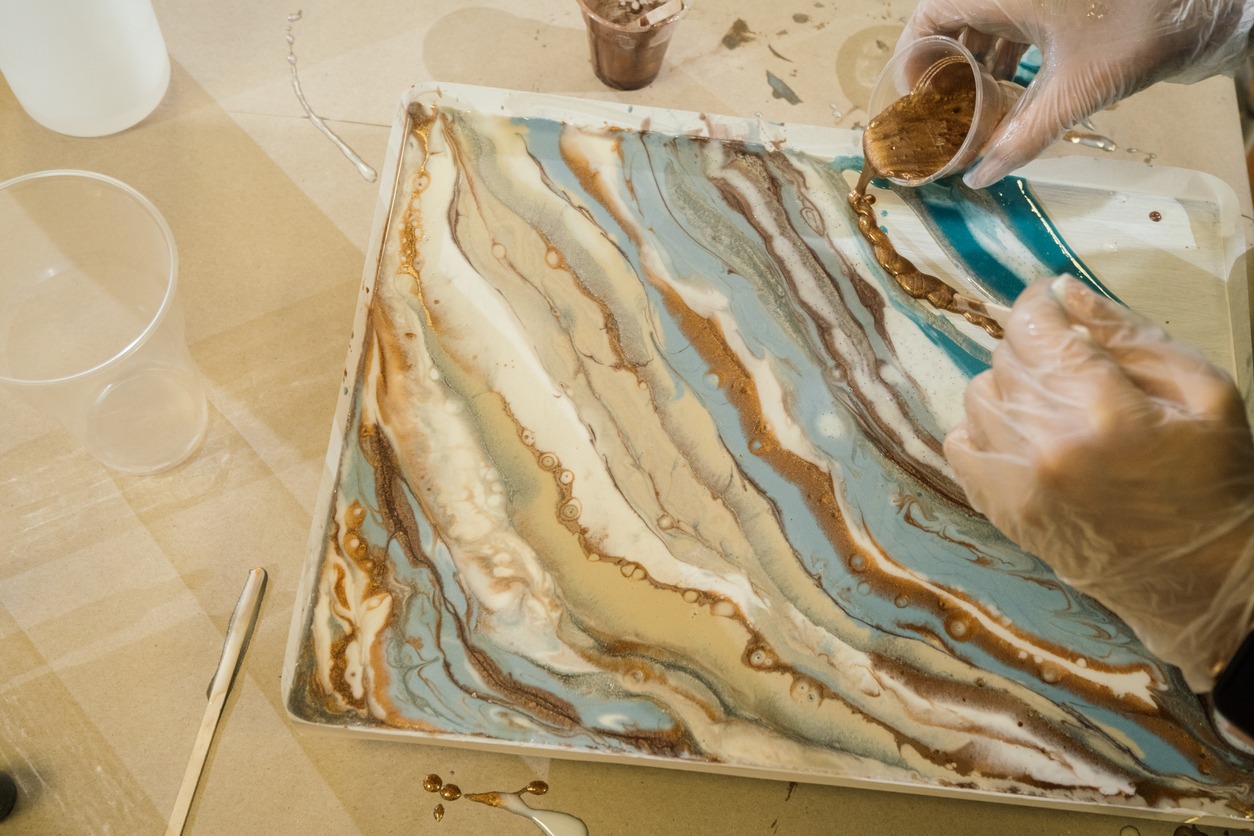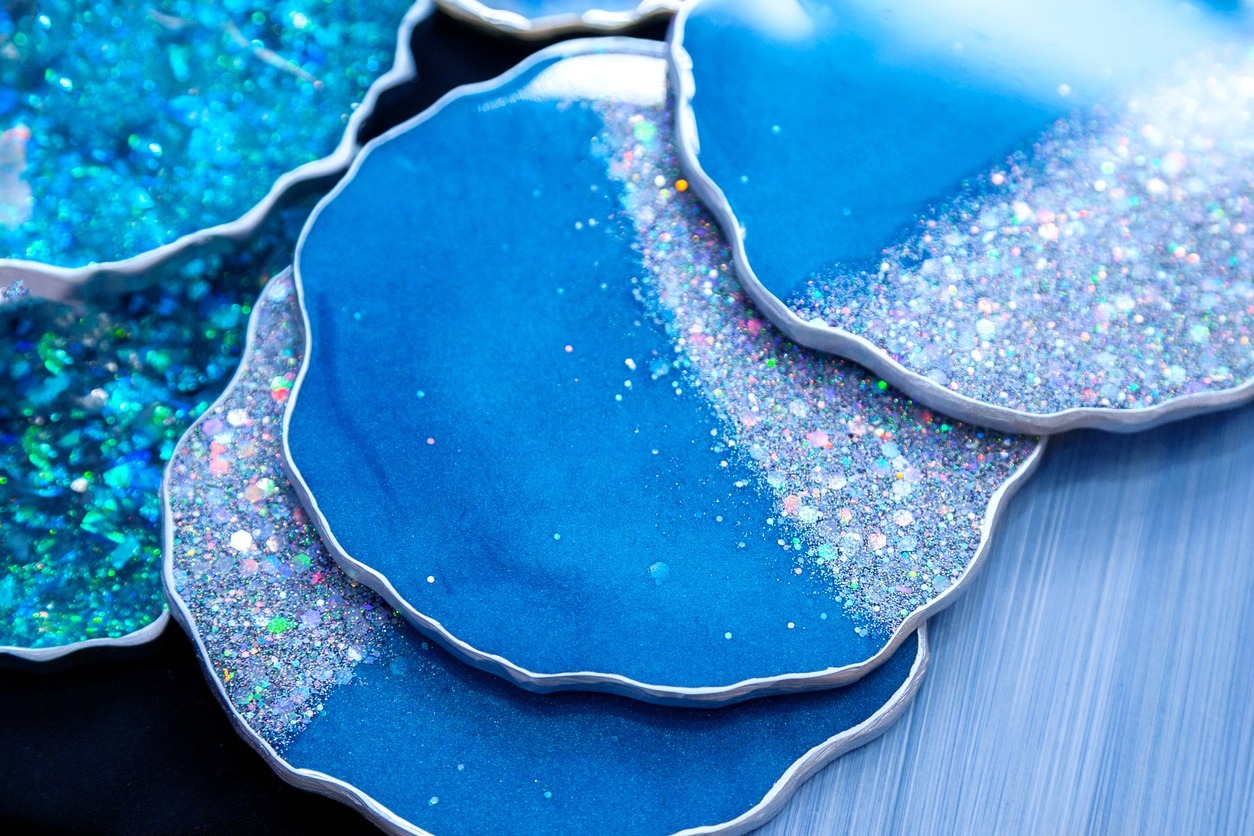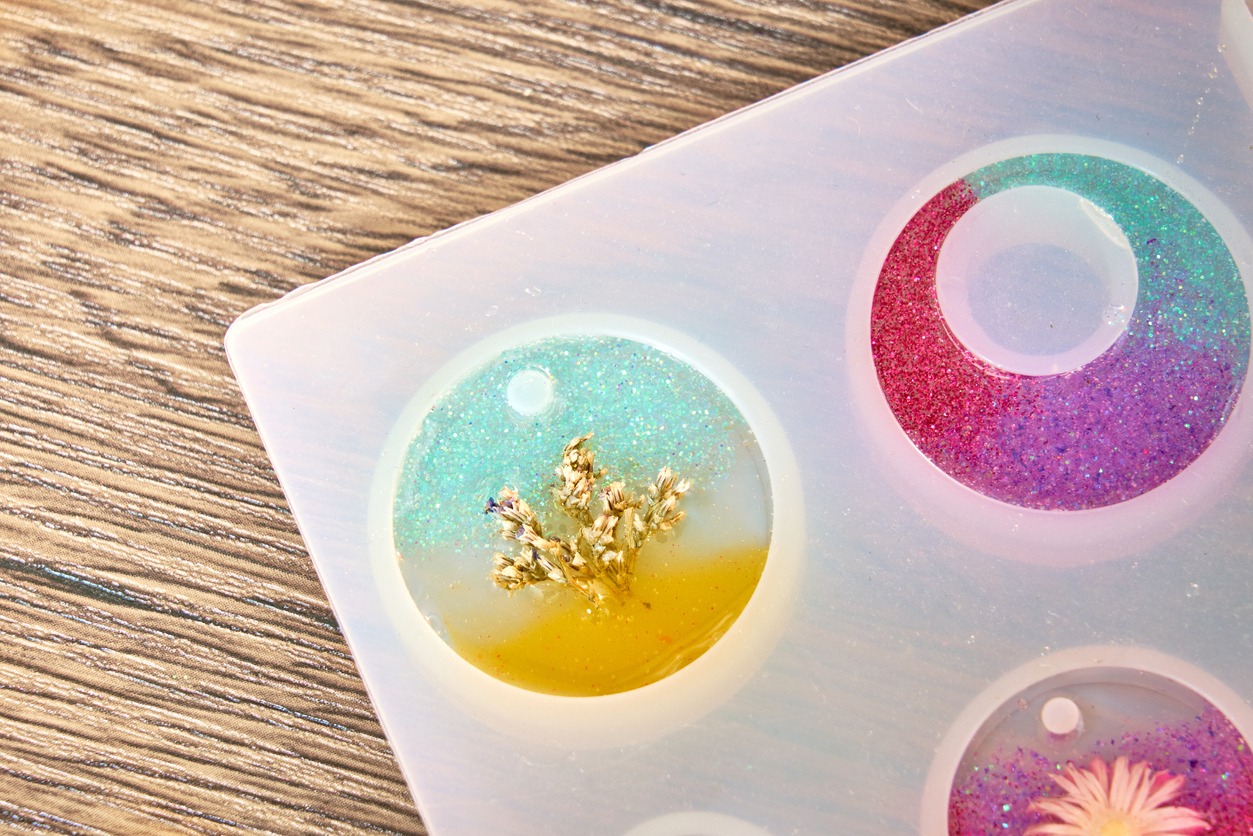Resin doesn’t sound like an artistic material, but once you see a stunning work of resin art, you’ll be eager to try it for yourself.
Resin is a fascinating chemical compound that transforms into a shiny, durable, and smooth plastic when it dries. In its pure form, it’s entirely transparent, but when combined with paints or poured onto various objects, it opens the door to a wide array of art and craft possibilities.
What is Resin?

When it comes to crafting, “resin” typically refers to synthetic resin, such as epoxy resin or casting resin. Synthetic resin consists of two components: part A, which is the resin, and part B, a hardener. These are both liquid until they blend, starting a hardening process that takes anywhere from 24 to 72 hours. Once fully cured, resin becomes non-toxic, solid, glossy, and waterproof. But while working with it, safety precautions are a must.
What is Epoxy?
When working with resins, you’ll often encounter epoxy. Epoxy resin, sometimes simply called epoxy, is a synthetic resin composed of liquid resin and a hardener. It’s often used as a coating to provide a durable, high-gloss finish.
What is Resin Art?
Resin art is a type of arts and crafts that prominently features resin (either epoxy or casting) as a key ingredient. Resin can be mixed with paints or inks to craft vibrant patterns, poured over paintings to create a thick, glossy protective layer, or used in molds along with items like dried flowers or shells. Resin art encompasses both abstract paintings and practical items, including jewelry and homewares.
Different Resin Types and Their Uses
If you’ve dabbled in epoxy resin art, you might be aware that there are several resin varieties available, each with unique properties and applications. Some are perfect for artistic endeavors, some excel at coating surfaces, while others are tailor-made for thick pours or industrial manufacturing. Regardless of the purpose, most resins share essential qualities like strength, durability, exceptional adhesion, and resistance to moisture and chemicals.
This guide will delve deeper into the characteristics and optimal uses for each type of resin, helping you select the perfect resin for your project.
Epoxy Resin
Epoxy resin is one of the most popular materials for resin art. It’s essentially a clear liquid plastic formed by blending two components: the resin and hardener. These are sometimes called Part A and Part B or the base and catalyst. When they mix, a chemical transformation occurs, turning the liquid resin into a solid material. This process typically takes 24-72 hours, and once it’s done, you have epoxy resin – a robust, long-lasting substance that’s resistant to moisture and chemicals. Epoxy resin is known for its high-gloss finish, excellent clarity, and ability to create thick, glass-like coatings. It’s versatile and can be used for various art applications.
There’s a variety of epoxy resins out there, tailored for specific purposes like art, coating, and casting. They come in different brands and quality levels, so when picking the right one for your project, consider your needs and the level of non-toxicity.
The application of epoxy resin depends on your specific project. In general, you layer it on, allowing each coat to dry before adding the next. While you can sand the initial coat, avoid sanding between additional coats.
When it comes to creative projects, opt for an epoxy resin formulated for resin art. These are valued for their clarity and user-friendliness, often featuring light stabilizers to prevent yellowing.
Art resin typically has a medium thickness, offering control for coating artwork, flow art, shallow mold pouring, and other thin applications. If you desire a thicker layer, simply build it up by applying resin layer by layer. It can be used clear or tinted with pigments, catering to a wide range of creative projects.
Keep in mind not all art resins are created equal. The best quality ones undergo third-party testing to confirm they are non-toxic, free of solvents and fillers, produce no fumes or VOCs, and are food-safe once cured. So, when shopping for art and craft epoxy, invest in top-notch quality and follow instructions diligently.
Pros:
- Epoxy resin is incredibly durable.
- It’s highly customizable, with various options for different projects.
- It’s cost-effective and readily available, suitable for a wide range of uses.
Cons:
- Exposure to direct sunlight may cause the epoxy resin to yellow over time.
- It requires a dry environment to cure properly, so it’s not the best choice for high-humidity settings.
Casting Resin
Casting resin is a type of epoxy resin made from a slightly different blend of chemicals. While traditional epoxy resin is commonly used as a coating, casting resin takes on a different role. It’s ideal for pouring into molds to craft items like coasters, trays, and jewelry, bringing a chunky and three-dimensional touch to your creations.
Its low viscosity means it flows like water, making it effortless to pour into confined spaces or molds. This consistency also allows any bubbles to naturally rise to the surface, resulting in a crystal-clear finish. However, the thinner nature of casting resin comes with a trade-off—it takes a bit longer to fully cure, typically up to a week, depending on thickness and temperature. The upside is its prized clarity, and it can be spiced up with liquid or powdered pigments for a splash of color.
Keep in mind that mixing ratios for casting resins may vary from one brand to another. You can find options with ratios like 2:1 or even 3:1.
When looking for a high-quality casting resin, aim for a water-clear formula capable of pouring several inches deep, ensuring a bubble-free cure. Top-notch casting resins are non-toxic, solvent-free, emit no fumes or VOCs, and come equipped with light stabilizers for long-term clarity.
Casting resin is great for:
- Filling deep molds
- Designing resin jewelry
- Encapsulating or suspending objects in resin, such as flowers, coins, insects, and more
- Crafting river tables
- Sculpting figurines and prototypes
- Filling voids in wood or other materials
Coating Resin
Coating resin, just as the name suggests, is used for adding a protective layer to surfaces like wood, metal, concrete, and fiberglass. Once it cures, it forms a robust shield that can stand up to chemicals, high temperatures, moisture, and wear and tear. This industrial-grade resin not only safeguards surfaces but also enhances their appearance.
The mixing ratio for coating resin can vary depending on the brand, with options like 1:1 (equal parts resin and hardener) or 2:1 (two parts resin to one part hardener).
While art resins are designed for pieces primarily on display, industrial coating resins step in to protect surfaces exposed to the elements or experiencing heavy use, like floors, bars, counters, and tabletops. They boast superior strength, hardness, and durability, built to endure years of use without bending or cracking.
Quality varies widely, even within the industrial coating resin category. Some industrial resins may cut corners by using cheap solvent fillers, potentially posing health risks during use.
When choosing an industrial epoxy resin, prioritize options that offer the needed strength and durability without compromising your health through fumes, solvents, or VOCs.
If you plan to use an industrial coating resin for surfaces that come into contact with food, always opt for a resin that has undergone third-party testing for food safety.
Coating resin is great for:
- Crafting wood river tables
- Making epoxy countertops
- Making resin bar tops
- Designing charcuterie platters and serving trays
- Making resin and wood lamps
- Coating floors, particularly ideal for concrete flooring
Polyurethane Resin
Polyurethane resin is a two-part system that transforms into a solid, rubber-like plastic when it cures. Known for its durability, it is used in various industrial applications, such as in manufacturing adhesives, coatings, insulation, sealants, casting molds, and even urethane foam. This versatile material is precisely formulated to meet specific physical and chemical needs, making different types of polyurethane resin invaluable across a range of industries, including appliances, automotive, apparel, packaging, and construction.
Polyurethane resin boasts properties like exceptional weather resistance, strong adhesion to surfaces, impressive impact strength, and resistance to wear and tear. When exposed to heat, it becomes remarkably hard and can withstand a wide array of chemicals and solvents. In fact, it’s the go-to adhesive for applications where exposure to gasoline or similar fuels is a possibility.
However, it’s essential to handle polyurethane resin with care, as it can emit noxious fumes, VOCs, and a respiratory toxin known as isocyanate. To stay safe, make sure you wear the appropriate personal protective gear, including a respirator, and work in a well-ventilated area.
Pros:
- Ideal for electrical encapsulation.
- Gains heat resistance once cured.
- Sets quickly.
- It is easy to mix and has excellent flow properties, making mold-filling a breeze.
- Minimal shrinkage during the curing process.
Cons:
- Not as adhesive as epoxy resin.
- Sensitive to moisture, which can lead to foaming.
- Produces an unpleasant odor during curing.
- It can’t be welded after curing.
- Requires an additional additive for UV resistance.
Polyurethane resin may not have the adhesive properties of epoxy resin, but its rapid setting, heat resistance, and versatile applications make it a valuable material.
UV Resin
If you’ve dabbled in jewelry-making, you might have encountered UV resin, a synthetic resin that cures quickly when exposed to ultraviolet light. UV resin is frequently used as a clear topcoat on a variety of surfaces, from wood and metal to plastic and fiberglass.
What sets UV resin apart is its simplicity. Unlike epoxy resin, which involves mixing two parts, UV resin comes in a single component and requires no blending. It cures rapidly under the influence of ultraviolet light, making it the go-to choice for projects that need a quick turnaround time.
One of UV resin’s notable advantages is its extended working time; it stays in liquid form until exposed to UV light. It’s also the quickest-drying resin available. On the flip side, it’s relatively expensive, needs the use of a UV lamp, and can only be applied in thin layers over smaller areas, making it unsuitable for some applications. It also has an unpleasant smell.
Pros:
- Extended working time, as it only sets when exposed to UV light.
- Speediest drying resin available.
- No mixing is required since it’s a single component, reducing the chance of errors.
Cons:
- Suitable for projects involving thin layers not ideal for large surface coverage.
- Limited shelf life, typically around six months.
- It is relatively expensive compared to other resin types.
- Requires a UV lamp for curing, which can be a pricey addition.
While UV resin excels in quick curing and ease of use, its application limitations and cost should be considered for your specific project.
Polyester Resin
Have you ever admired the sleek, glossy finish on boats and cars? Chances are, it’s polyester resin at work.
Polyester resin, a robust type of plastic, is renowned for its exceptional strength, rigidity, and resistance to water. It’s a versatile resin employed in various applications, such as laminating objects and crafting automobile parts, boat hulls, swimming pools, ponds, molds, models, and specific medical devices.
Working with polyester resin involves blending its two components – the resin and hardener. The amount of hardener determines how quickly the resin cures. Once the components are combined, they must be thoroughly mixed to prevent settling at the bottom of the container. Afterward, you can use the resin for laminating or mold-making. When creating molds, apply the resin in one direction to avoid trapping air bubbles in the glass fiber. The amount of hardener dictates the curing time, making precise mixing ratios a bit tricky.
Polyester resin is infamous for its pungent odor, noxious fumes, and corrosive components, so wearing the right personal protective gear is a must, including chemical-resistant gloves and respiratory protection.
Pros:
- Polyester resin is water-resistant.
- It’s a cost-effective resin.
- You have control over the drying time, as it’s linked to the amount of hardener used when mixing the resin components.
Cons:
- The mixing process can be more intricate than with other resins, as you’re responsible for calculating the required levels when combining the two components.
- Polyester resin is notorious for emitting a potent, unpleasant odor.
When using polyester resin for laminating, begin by applying the initial layer of resin to the surface, followed by a sheet of glass fiber. Then, add another layer of resin to make the glass fiber mat pliable and easy to shape.
Choosing the Perfect Resin for Your Project
Whether your artistic style is abstract, unconventional, or somewhere in between, resin art offers endless creative possibilities. Think outside the box, and let your imagination run wild with it! But as you have fun, remember to prioritize safety when handling resin.
Selecting the suitable resin depends on the demands of your specific project. No matter your resin of choice, always heed the label instructions for the best results. Your project will determine the type of resin you choose, but rest assured that the perfect option is out there, waiting for you.


